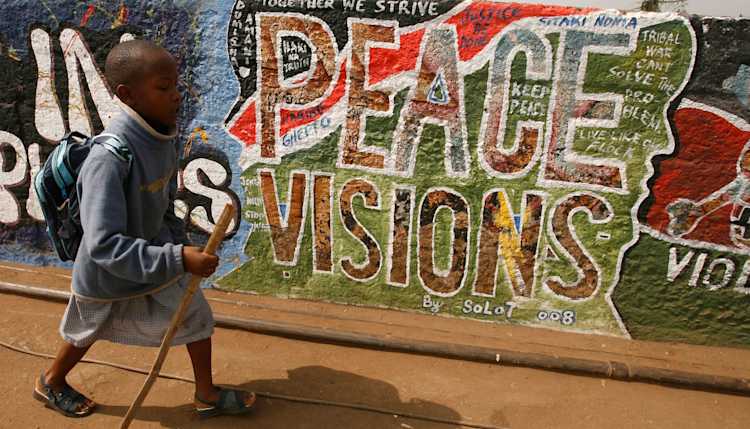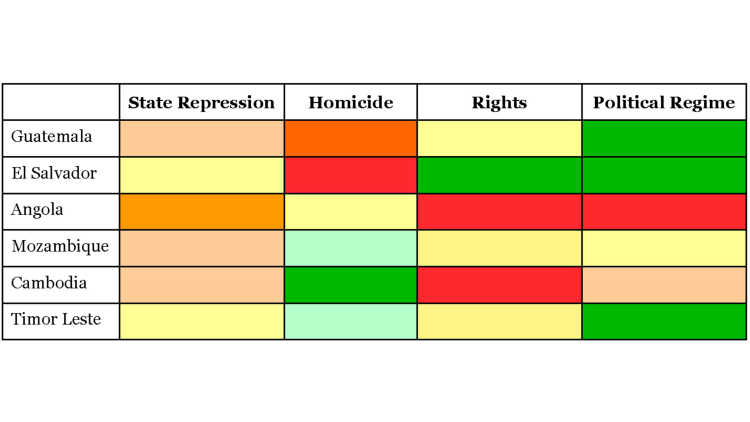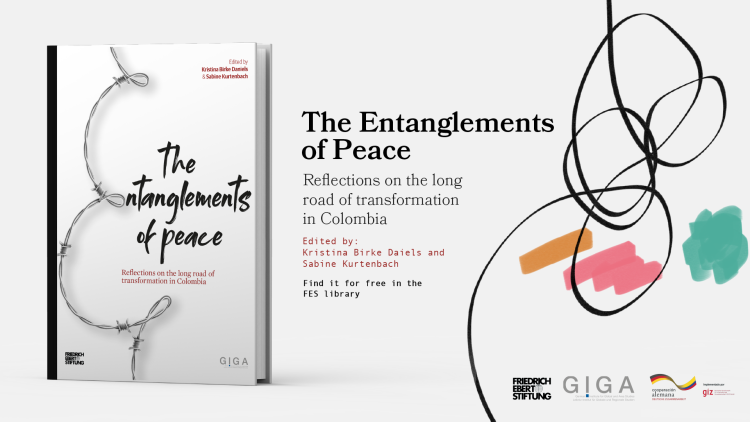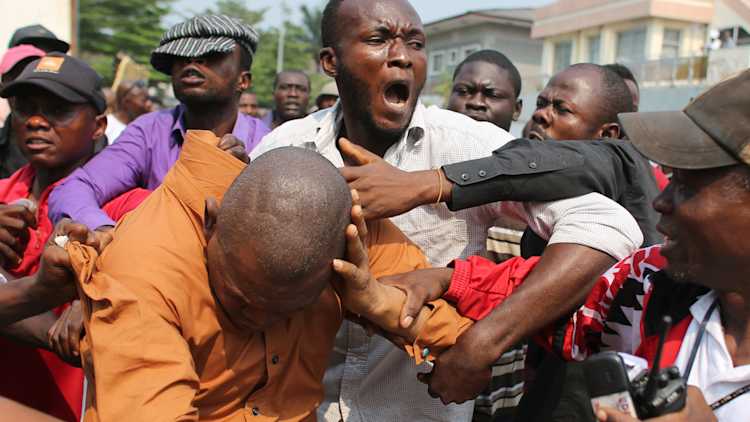- Home
- Publications
- GIGA Focus
- No One Size Fits All – A Global Approach to Peace
GIGA Focus Global
No One Size Fits All – A Global Approach to Peace
Number 5 | 2017 | ISSN: 1862-3581

People tend to agree on the vital importance of peace, but there is no consensus on what peace is and even less so on how it can be accomplished and secured. International peace-building strategies privilege a concept of peace that stems from Western experiences of a centralised democratic state. A global approach to peace needs to include the experiences of the Global South and to focus on reducing various forms of violence rather than simply ending war.
Peace is a complex process that is influenced by social, economic, and political structures; a variety of actors; and a multitude of policies. Current post-war societies reveal a high degree of variation regarding post-war violence and changes to the political system.
A global approach to peace is required in order to include the diverse cultural and historical experiences of all regions across the globe. There is no shortcut to or way to replicate the state-centred Western development path.
An interregional comparison of violence patterns suggests that conflicts are closely related to processes of social change at the intersection of increasing globalisation and local, salient cultural and historical trajectories. The analysis of these conflicts is thus the necessary starting point for peace-building strategies.
Peace-building strategies must focus on violence reduction and non-violent conflict transformation. The termination of war is an essential first step but does not suffice. Although the specific arrangements to end collective violence are shaped by the incompatibilities and structures of conflicts, such agreements need to be open to future change.
Policy Implications
External support for peace processes by the German government, the European Union, or the United Nations needs to take seriously the claims and interests of various local constituencies and the fact that peace processes are a form of contentious politics. Promoting peace is not about following a single globalised template but rather about searching for common ground in order to end violence and non-violently transform conflicts.
Concepts of Peace
Peace is a complex concept and has a variety of definitions and indicators. A minimum criterion is the absence of war – that is, organised political violence between at least two actors. The current war in Syria has produced more than 400,000 casualties and thus shows how important war termination is or can be for those affected. However, concepts of peace must go beyond such a narrow understanding and take into account other forms of collective violence. Otherwise, countries not at war but with high levels of other forms of violence would formally be at peace. Examples are Myanmar, where the massive displacement of Rohingya is widely regarded as one-sided violence by government forces; Mexico, where organised violence by drug cartels is generally framed as criminal violence; and Burundi, which has seen more than 300,000 people flee since 2015 according to the United Nations High Commissioner on Refugees (UNHCR).
Broader concepts of peace exist in other historical and cultural contexts (see Galtung 1981). Such concepts focus not only on reducing direct physical violence but also on enhancing people’s possibilities to fulfil their potential. Current peace-building strategies adopt a sequential approach: they focus first on ending war and then on introducing reforms aimed at increasing participation. In Central America, for example, reforms targeting social and economic inequality were delegated to the political system and did not form part of the peace agreements although the marginalisation of large segments of the population was a main structural driver of the region’s civil wars. But with the end of war, peace was no longer a priority on the political agendas, which had turned towards “normal” problems. Post-war protests against the prevailing neoliberal policies were largely criminalised, and the problem of security and crime dominated the public discourse, demobilizing social protests and undermining democratic reforms.
Even if we agree that peace is more than the absence of war or other manifestations of violence, the pathway to peace remains long, complicated, and non-linear. This became evident following the Cold War, when international peace-building strategies defined peace as the absence of external and internal war in politically democratic and market-oriented societies; this was known as the liberal peace-building concept. It was based on the experiences of Western developed countries, state centred, and highly normative. There are very serious doubts about whether this can be reproduced in other world regions and whether it can be done in a short period of time. Achieving peace cost Europe many centuries and millions of victims. Today, Europe continues to witness many manifestations of violence (e.g. against women, migrants, and other marginalised groups), and it is far from certain that post–World War II peace is irreversible.
Experiences with the liberal peace-building suggest that there is no shortcut to peace using a Western template. In El Salvador and Guatemala in Central America, Mozambique and Angola in Southern Africa, and Cambodia and Timor Leste in Southeast Asia, the United Nations and other international actors supported liberal peace-building in the early 1990s. Although none of these countries has experienced war recurrence, the data on violence and democratic reforms (state repression, homicide, political and civil rights, the political regime), show that they have only enjoyed mixed success with liberal peace-building (see Table 1).

The data suggest that there is no obvious or linear relationship between violence indicators, the guarantee of civil and political rights, and political regime. For example, despite being the most violent country, El Salvador also scores highest with regard to political transformation. Timor Leste, seemingly the most promising example of liberal peace-building, has experienced increasing levels of violence and authoritarianism according to reports. Meanwhile, Mozambique is seemingly in danger of witnessing 20 years of peace come to an end following the Mozambican National Resistance’s (RENAMO) 2013 decision to quit the peace agreement because it did not see any chance of a democratic change of power. The data illustrate the fact that there are no cohesive patterns of post-war development that are in keeping with the liberal peace-building paradigm. The following section presents a global approach to peace that focuses on violence reduction and non-violent conflict transformation. Such an approach may help to overcome analytical Eurocentrism and provide new insights for peace-building policies.
A Global Approach to Peace
Although made in the context of the Cold War, former German chancellor and Nobel Peace laureate (1971) Willy Brandt’s quote that “Peace is not everything. But without peace, everything is nothing” is still relevant today given the broad consensus on the vital importance of peace for development, economic growth, political participation, and social cohesion, among others. In a peaceful society it is not just the absence of war or collective armed conflict that matters; various other forms of direct physical violence also need to be reduced or eradicated.
The first crucial element in the development of a global approach to peace is the proposition that the opposite of peace is not war but rather various forms of direct physical violence (Pearce 2016). Decisive for peace is thus the absence, reduction, and control of direct physical violence. This goes beyond the narrow understanding of peace but does not overstretch the concept by including the absence of structural and cultural forms of violence. At the same time, this concept of peace is not state centred and is therefore comparable across different world regions. Nevertheless, comparable data are a problem due to the controversial issue of framing, which is a result of fragmented research along disciplinary lines and the over-reporting, under-reporting, or lack of statistics. Data on violence are highly disputed and many times part of the conflict. This is not just an academic problem; it also has serious repercussions for policies. Violence framed in the tradition of Clausewitz as “the continuation of politics by other means” has a certain level of legitimacy, while violence framed as “greed” and serving only personal enrichment lacks legitimacy. Ending political violence can be discussed or negotiated by the relevant actors, whereas so-called criminal violence calls for law enforcement. However, boundaries are blurred and a clear-cut distinction is not possible. Actors can change their discourse, or the perception of actors can change. Many liberation movements such as the South African National Congress or the Vietcong were regarded as “terrorists” during the Cold War. Later, the legitimacy of their social, political, and economic claims was recognised, and most of these groups were accepted internationally. The question is thus who frames specific forms of violence as legitimate or illegitimate? At the same time, there is an increasing acknowledgement that different manifestations of violence are closely related (Davenport 2007).
A second vital element of a global approach to peace is the assumption that conflicts are a given in any society and that their non-violent transformation is a key condition for peace. The idea of transformation goes beyond the management or resolution of specific conflicts, including changes at the structural level (Mitchell 2002). To develop a strategy that can tackle conflicts, it is necessary to examine global history to find evidence of violence reduction and peaceful coexistence as well as non-Western state-centric models of conflict transformation. A comparative area studies approach that combines the context sensitivity of area expertise with disciplinary knowledge can contribute to both the generalisation and better specification of research findings (Acharya 2014). This does not disqualify universal norms and values regarding human rights. On the contrary, such an approach recognises and builds on the Global South’s contributions to many of the norm-generating processes regarding violence and human rights after World War II (Sikkink 2014). These norms provide a shared frame of reference in a world increasingly interconnected via political, economic, and social globalisation.
Peace research has provided vast evidence that processes of change are contentious and very much prone to conflict. However, we know little about the variations in change-related conflict across the globe. Social change affects the structures of society and provokes realignments of the relations and the distribution of power between central actors. In the twenty-first century growing interdependence and a multitude of (state and non-state) actors influence and shape these processes. A comparative frame for the analysis of peace and conflict transformation needs to start with the analysis of these conflicts and their specific expressions. The following section will provide some empirical evidence on the major patterns of conflict and violence from a comparative area studies perspective.
A Comparative Analysis of Conflicts and Violence
Comparing the most recent data on conflicts unveils some interesting regional variations as well as multiple patterns of peace-building worldwide. Regarding violence, we can see that armed conflicts are most common in sub-Saharan Africa, followed by the Middle East and then Asia. State repression is most intense in South Asia, followed by the Middle East and North Africa and then sub-Saharan Africa. In terms of homicides, the Americas are the most violent, followed by sub-Saharan Africa, where as Asia has the lowest homicide rate. However, when it comes to environmental conflicts, Latin America has the highest numbers. Regarding mass mobilisation the highest level of protester violence (2000–2014) is documented for Ivory Coast in Africa, Bangladesh in Asia, Turkey in the Middle East, Brazil in South America, and Greece in Europe. A systematic review of these (and, potentially, other) data could provide evidence of regional and subregional patterns of conflict, violence, and peace-building opportunities.
Nonetheless, the data also hide within-region variations. For example, the data on armed conflict in South East Asia for the period 1945–2016 are highly influenced by the violence in Myanmar, which accounts for nearly half of the conflict years; in the case of Latin America, the armed conflict data is highly biased by the violence in Colombia.
The academic debate on collective violence focuses on two main incompatibilities: control of territory and government. Territorial control has historically triggered conflict and violence across the globe. The most prominent theories on state formation and war analyse this link (Tilly 1985; Toft 2014). Even in a world of sovereign states where borders are internationally guaranteed, this issue remains a topic of conflict – as evidenced by secessionist movements in Ukraine and Spain, for example. Government conflicts, on the other hand, are about political order and the legitimacy thereof. They involve various manifestations of violence with actors typically looking to overthrow the government, enforce participation, change the rules of the game, or secure power via repression (Cederman, Hug, and Krebs 2010; Davenport 2007). Government conflicts have occurred across different regions in specific historical settings. During the second half of the twentieth century, nearly all Latin American armed conflicts were fought between guerrilla movements and authoritarian governments. Similar conflicts can be observed in sub-Saharan Africa and Asia, although the patterns of mobilisation differ there.
During the last decade, non-state violence received a lot of attention due to the debate on the “new wars.” This category transcends the state-centric definition of war because the state is not directly part of the conflict. Here, non-state armed actors fight for control of territory, resources, and people. Although most armed actors are labelled “criminals” due to their lack of an explicit political agenda, such conflicts resemble early state-formation experiences, and such actors are similar to Tilly’s (1985) “stationary bandits.”
We also need to take into account that each region hosts a small number of countries with very few or no incidents of armed conflict and low levels of repression and homicide. Botswana, Uruguay, and Bhutan are exceptional in regard to violence. However, our knowledge of the relevant factors (i.e. actors, structures, and institutions) is rather limited. It is quite surprising that economic development seems to be of less importance than regime stability (Ansorg and Schultze 2014). The Institute for Economics & Peace (2017) attempts to measure peacefulness across the globe with its Positive Peace Index, which includes eight pillars: (1) high levels of human capital, (2) equitable distribution of resources, (3) well-functioning government, (4) low levels of corruption, (5) acceptance of the rights of others, (6) good relations with neighbours, (7) free flow of information, and (8) a sound business environment.
All of these are fundamental to the peaceful coexistence between and within societies. However, it is not possible to reverse engineer the findings of such studies in order to create roadmaps for action. Implementing peace-related policies is a contentious difficult process and could even produce violence. Policies related to resource distribution, well-functioning government, low levels of corruption, and the acceptance of the rights of others also generate conflict and are difficult to implement. Hence, it is essential to analyse the relevant conflicts, old and new.
Despite variation in the specific dynamics and manifestations, all these conflict types are related to the broader processes of social change, which challenge existing patterns of territorial control and political order. Globalisation and the spread of capitalism link various cultural contexts and social change. However, specific interactions produce a variety of results. For example, patterns of mobilisation differ across time and space. In Europe interstate war and nationalism played a major role in state-formation and nation-building. In the Global South this process shows a broad range of outcomes: In Latin America nationalism was rare, and mobilisation was built on ideology, clientelism, or populism. In sub-Saharan Africa and the Middle East ethnic and religious patterns of mobilisation continue to play an important role. In East Asia and South Asia nationalism is more prevalent than in Southeast Asia, where ethnic and religious forms of mobilisation are more common. These patterns of mobilisation, as well as the related cultural and historical values and norms, not only play a key role in war and collective violence but also shape the nature of peace processes and the non-violent transformation of conflicts. Elite accountability is important in all contexts but even more so where state repression or resource conflicts dominate. Recognition of indigenous or religious rights provides a basis for peace in regions that have experienced ethnic and religious mobilisation. Participation cannot be reduced to voting once in a while. Multiple forms of violence require multiple pluralist answers.
Peace-Building without Shortcuts
Current debates on peace-building strategies centre on the viability of the liberal peace paradigm, which views negotiated war terminations, comprehensive peace accords, and democratisation as the most important milestones. Critics of this approach highlight its emphasis of Eurocentric and state-centred models, a lack of local ownership, and the production of hybrid institutions that may cause more problems than they help to solve. Nevertheless, the empirical evidence on what does and does not promote violence reduction and increase participation is mostly inconclusive (see Table 1 above). A major shortcoming of the “liberal peace” approach is that it solely focuses on political participation (mostly elections), while increasing social and economic participation are delegated either to the political system or to development cooperation. In settings with high levels of corruption and clientelism this strategy is bound to fail (Haass and Ottmann 2017). Whereas reform causes instability, illiberal peace (which prioritises stability over change) contradicts many global human rights norms. At the same time, authoritarian structures may produce new conflicts, war recurrence, and/or other manifestations of violence. Post-war developments in Angola and Cambodia are evidence of the high levels of conflict and increasing state repression that can occur during authoritarian peace-building.
A global approach to peace could enable us to circumvent normative debates and make it possible to bridge narrow and broad peace concepts. Global peace-building strategies need to focus on the following elements:
Reducing direct physical violence: Violence is the opposite of peace, and peace-building strategies need to focus on reducing various forms of violence. Because controlling violence is a key challenge in maintaining social order, a global approach should look to combine traditional and new, formal and informal state and societal institutions in order to reduce the use of direct physical violence and facilitate non-violent forms of resistance. Existing justice systems and context-specific ideas on justice need to be reconciled with global norms.
Promoting win-win solutions: Existing conflicts and their relations to the broader processes of social change need to be analysed and must constitute the main frame for peace-building strategies. A violent conflict between elites over political participation will require solutions different from those for a conflict between elites and marginalised groups over economic and social participation.
Ensuring peace-building strategies are open to future change: While it might be necessary to focus on accommodating armed elites to stop mass violence, this should not preclude adjustments or changes when they become feasible. Impunity after the end of war is a case in point. Few (state and non-state) armed-groups leaders will agree to cease violence if they face long prison sentences. Nonetheless a minimum acknowledgement of past atrocities is necessary to signal that violent behaviour will not be tolerated. With time, it might be possible to find new pathways to reconciliation and recognition, such as truth-telling as a condition for amnesty or reduced punishment.
Policy Implications
A global approach to peace differs from a sequential liberal peace approach, which is based on a rather linear pattern of stopping mass violence first, stabilising second, and transforming last. Recurring cycles of violence and the closing of spaces for participation show that we need more creative and comprehensive strategies. The ongoing peace process in Colombia reveals the many challenges involved in complex conflict settings. The peace agreement between the government and the Revolutionary Armed Forces of Colombia (FARC) includes important provisions for conflict transformation, such as support for small-scale agricultural livelihoods. However, this remains a highly contentious issue for local and regional elites, who perceive these rather small reforms as a threat to their social and economic status. Instead of finding ways to make this a win-win situation, the resulting political polarisation has endangered the overall process. At the same time, a variety of violent actors are trying to capitalise on the lack of consensus regarding the scope of peace. Successfully implementing the peace accord requires (i) a quick peace dividend for the larger population, (ii) support for local peace constituencies monitoring the implementation of the agreement, and (iii) advocacy for a broader process of non-violent conflict transformation.
In general, internal and external peace-builders need a roadmap to guide them along the extensive and difficult path from collective mass violence to broader concepts of peace. Reducing violence, delivering a minimum level of justice to the victims, and redistributing economic and social resources need to be included in context-specific variation of any such roadmap. It might be necessary to promote a somewhat narrow notion peace without losing sight of the requirements of a broader concept of peace.
The World Bank and the United Nations’ new flagship report on violence prevention (United Nations and World Bank forthcoming) and the German government’s guidelines on crisis prevention (The Federal Government 2017) are important steps in the right direction. They highlight the need to support changes at the structural and institutional levels and to strengthen and cooperate with reform-oriented actors. Inclusiveness is the new buzzword. However, the translation of these guidelines into concrete policies depends on the reform of the international economic and social order as well as on the willingness of actors on the ground. These are both highly contentious arenas. Past experiences with comprehensive peace agreements reveal the difficulties this entails. While many of these agreements include more or less detailed provisions for important reforms, implementation is mostly limited to immediate security provisions. Even where civil society has mobilised in favour of war termination, other priorities shape the everyday life afterwards. Therefore, local peace constituencies are needed to monitor agreements and advocate for non-violent conflict transformation. In many post-war contexts change agents (e.g. social movement representatives, human rights advocates, or the independent media) are threatened or become victims of selective political violence. As international actors leave for the next theatre of acute crisis, local power relations take over. A profound non-violent conflict transformation can only occur if direct physical violence is penalised and delegitimised. This requires local and external actors to have long time perspectives and to clearly prioritise peace across all policy fields.
Footnotes
References
Acharya, Amitav (2014), Global International Relations (IR) and Regional Worlds: A New Agenda for International Studies, in: International Studies Quarterly, 58, 4, 647–659.
Ansorg, Nadine, and Kim Schultze (2014), Friedensinseln in Subsahara-Afrika, GIGA Focus Afrika, 5, Juni, www.giga-hamburg.de/de/publication/friedensin seln-in-subsahara-afrika (17 November 2017).
Cederman, Lars-Erik, Simon Hug, and Lutz F. Krebs (2010), Democratization and Civil War: Empirical Evidence, in: Journal of Peace Research, 47, 4, 377–394.
Center for Systemic Peace (2014), Polity IV Country Reports 2010, www.systemic peace.org/p4creports.html (17 November 2017).
Davenport, Christian (2007), State Repression and Political Order, in: Annual Review of Political Science, 10, 1, 1–23.
Freedom House (2017), Populists and Autocrats: The Dual Threat to Global Democracy, https://freedomhouse.org/report/freedom-world/freedom-world-2017 (17 November 2017).
Galtung, Johan (1981), Social Cosmology and the Concept of Peace, in: Journal of Peace Research, 18, 2, 183–199.
Haass, Felix, and Martin Ottmann (2017), Profits from Peace: The Political Economy of Power-Sharing and Corruption, in: World Development, 99, 60–74.
Institute for Economics & Peace (2017), Global Peace Index 2017, Sydney, New York: IEP.
Mitchell, Christopher (2002), Beyond Resolution: What does Conflict Transformation Actually Transform?, in: Peace and Conflict Studies, 9, 1, 1–23.
Narlikar, Amrita (2016), “Because They Matter”: Recognise Diversity—Globalise Research, GIGA Focus Global, 1, April, www.giga-hamburg.de/en/publication/because-they-matter (17 November 2017).
Pearce, Jenny (2016), The “Violence Turn” in Peace Studies and Practice, in: Barbara Unger, Véronique Dudouet, Matteo Dressler, and Beatrix Austin (eds), “Undeclared Wars” – Exploring a Peacebuilding Approach to Armed Social Violence, Berghof Handbook Dialogue Series 12, Berlin: Berghof Foundation, http://image.berghof-foundation.org/fileadmin/redaktion/Publications/Handbook/Dialogue_Chapters/dialogue12_armedsocialviolence_pearce.pdf (17 November 2017). Political Terror Scale (2017), The
Political Terror Scale, www.politicalterrorscale.org/ (17 November 2017).
Sikkink, Kathryn (2014), Latin American Countries as Norm Protagonists of the Idea of International Human Rights, in: Global Governance, 20, 3, 389–404.
The Federal Government (2017), Preventing Crises, Resolving Conflicts, Building Peace, Berlin: Federal Foreign Office.
The World Bank (2017), Homicide Data, https://data.worldbank.org/indicator/VC.IHR.PSRC.P5 (17 November 2017).
Tilly, Charles (1985), War Making and State Making as Organized Crime, Cambridge: Cambridge University Press.
Toft, Monica Duffy (2014), Territory and War, in: Journal of Peace Research, 51, 2, 185–198.
United Nations, and World Bank (forthcoming), Pathways for Peace: Inclusive Approaches to Preventing Violent Conflict.
General Editor GIGA Focus
Editor GIGA Focus Global
Regional Institutes
Research Programmes
How to cite this article
Kurtenbach, Sabine (2017), No One Size Fits All – A Global Approach to Peace, GIGA Focus Global, 5, Hamburg: German Institute for Global and Area Studies (GIGA), http://nbn-resolving.de/urn:nbn:de:0168-ssoar-54880-7
Imprint
The GIGA Focus is an Open Access publication and can be read on the Internet and downloaded free of charge at www.giga-hamburg.de/en/publications/giga-focus. According to the conditions of the Creative-Commons license Attribution-No Derivative Works 3.0, this publication may be freely duplicated, circulated, and made accessible to the public. The particular conditions include the correct indication of the initial publication as GIGA Focus and no changes in or abbreviation of texts.
The German Institute for Global and Area Studies (GIGA) – Leibniz-Institut für Globale und Regionale Studien in Hamburg publishes the Focus series on Africa, Asia, Latin America, the Middle East and global issues. The GIGA Focus is edited and published by the GIGA. The views and opinions expressed are solely those of the authors and do not necessarily reflect those of the institute. Authors alone are responsible for the content of their articles. GIGA and the authors cannot be held liable for any errors and omissions, or for any consequences arising from the use of the information provided.




















